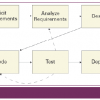acceptance testing
 |
Build Just Enough of a Feature with ATDD Developers have a tendency to overbuild their code. This is frequently due to not knowing exactly when they're done and not knowing how robust a feature needs to be. Acceptance test-driven development (ATDD) is a great way to avoid this practice because when the acceptance test passes, the developer knows they're done building that particular feature.
|
|
 |
Teaching Acceptance Test-Driven Development Acceptance test-driven development is a whole-delivery cycle method that allows the entire team to define system behavior in specific terms before coding begins. These conversations align the expectations of the testers, developers, and product owners, forcing any silly arguments to happen before someone has to create the code twice. Here are some great beginner exercises for teaching ATDD.
|
|
 |
Testing during Transition: Test Criteria for Outsourced Software In the world of IT outsourcing, it is not uncommon for a company to have its applications and infrastructure developed or maintained by others. As vendors compete for this business, a common trial is testing the transition activity as a whole. How would you design acceptance criteria of a transition trial so that it is testable and clearly communicated?
|
|
 |
Building a Better RoboCop: The Stages of Software Testing In the movie RoboCop, the cyborg law enforcement officer advised people to “Stay out of trouble.” This article focuses on ways to stay out of trouble when building a software product by following the stages of software testing, using the 1987 movie’s titular character as an example. Let’s examine each testing stage and see if we can build a better RoboCop.
|
|
|
|
Gain Greater Testing Precision Through Adaptive Test Methods Brooke Bowie explains how "adaptive" software testing provides nimble, high-value software test solutions that bend and shift with the changing needs of the market or the environment. High-value testing does not mean that you need to perform all end-to-end testing or run the full suite of tests; this can potentially create a bottleneck and dampen the velocity. Adaptive tests are always targeted at the most relevant business and quality goals.
|
|
 |
Increase Quality with Table-Driven Acceptance Tests Vague or ambiguous requirements can cause loops in development processes. Creating requirements that include acceptance tests cuts down on the looping and increases the flow of working software to the customer.
|
|
 |
From Here to Acceptance Test-Driven Development Acceptance test-driven development (ATDD) means different things to different people based on their experiences—from "It's all about testing" to "It has nothing to do with testing,” and from "TDD, ATDD—it's all the same" to "TDD and ATDD are nothing alike." These nine landmarks will help you navigate ATDD no matter where you are coming from.
|
|
 |
Using Behavior Driven Development and Acceptance Test-Driven Development to create GREAT requirements
Slideshow
Defining, understanding, and agreeing on the scope of work to be done is often an area of discomfort for product managers, business analysts, developers, and quality assurance experts alike. The origin of many items living in our defect tracking systems can be traced to the difficulties encountered while performing these initial requirements activities. Ken Pugh introduces behavior-driven development (BDD), also known as acceptance test-driven development (ATDD), and explains how it works in creating detailed requirements. He outlines the different roles that team members play in the process. BDD/ATDD has proven to dramatically increase productivity and reduce delays in development by decreasing re-work due to requirement misunderstandings.
|
Ken Pugh
|
 |
Accessibility Standards and Testing Techniques: Be Inclusive or Be Left Behind
Slideshow
While Information and Communication Technology (ICT) accessibility for a wider spectrum of users—including the blind—and their interfaces is being required by law across more jurisdictions, testing for it remains limited, naïve, and too late. The consequences of staying ignorant include...
|
David Best, Sandy Feldman, and Rob Harvie
|
 |
Requirements and Acceptance Tests: Yes, They Go Together
Slideshow
The practice of software development requires a clear understanding of business needs. Misunderstanding requirements causes waste, slipped schedules, and mistrust. Developers implement their perceived interpretation of requirements; testers test against their perceptions. Disagreement can...
|
Ken Pugh, Net Objectives
|
 |
User Acceptance Testing in the Testing Center of Excellence
Slideshow
Centralization of testing services into a testing center of excellence (TCoE) for system testing is common in IT shops today. To make this transformation mature, the next logical step is to incorporate the user acceptance testing (UAT) function into the TCoE. This poses unique challenges...
|
Deepika Mamnani, Capgemini
|
Visit Our Other Communities
StickyMinds is a TechWell community.
Through conferences, training, consulting, and online resources, TechWell helps you develop and deliver great software every day.
